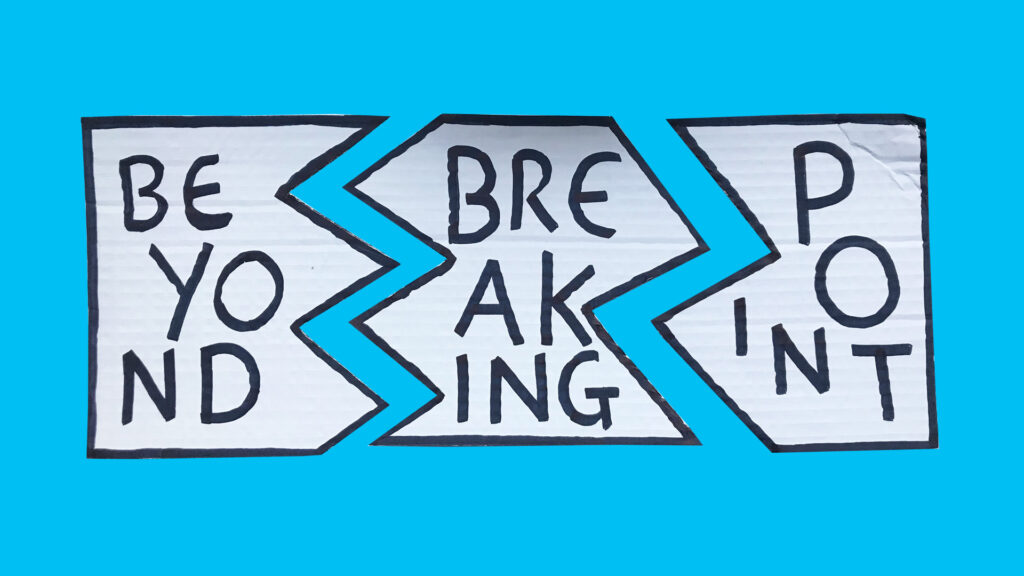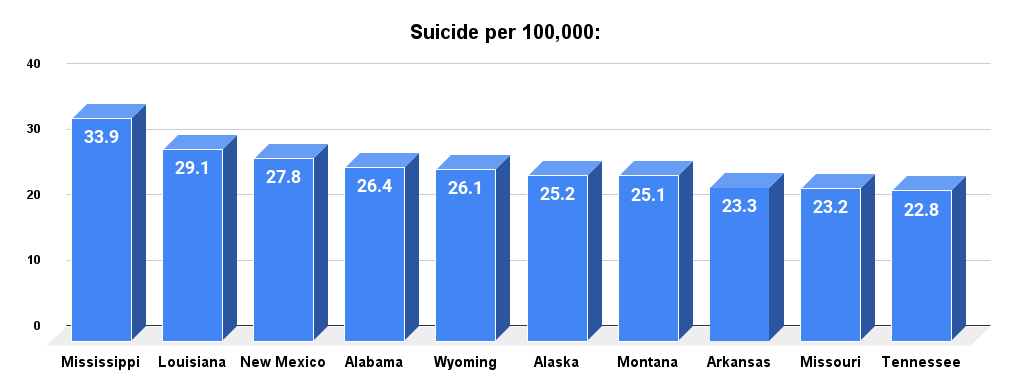
“Beyond Breaking Point” – When Will the Mental Health Crisis Finally Be Taken Seriously?
Formrush just published a fascinating new study on which countries have the highest suicide rates recently.
We researched nationwide data, analyzing suicides in all states of the US.
Instead of neglecting the worsening mental health crisis, it’s vital to direct our attention toward the regions most profoundly affected by the tragic issue of suicide. Recent data points out the ten states in America that have the highest suicide rates.

Mississippi: 33.9
per 100,000– With 19.1% of Mississippi residents living below the poverty line and just 22.8% holding college degrees, limited economic opportunities, and access to care drive elevated suicide risk across the state.
Louisiana: 29.1 per 100,000– Louisiana’s unemployment remaining slightly elevated at 3.3% paired with mounting average personal debt climbing to $45,830 demonstrates strained economic climates that introduce mental health vulnerabilities tied to increasing suicide levels statewide.
New Mexico: 27.8 per 100,000-month recreational drug use affecting over 14% of residents and education attainment lagging at just 28.1% holding college degrees, while unemployment also hovers higher near 4%, New Mexico struggles with substance abuse and economic opportunity barriers that multiply suicide risk indicators.
Alabama: 26.4 per 100,000– Alabama faces substance abuse risk with recreational drug use hitting nearly 11% while just 26.2% obtain college degrees. Compounding matters, residents carry heavy personal debt approaching $70K – combined economic constraints tied to rising suicide levels.
Wyoming: 26.1 per 100,000– While Wyoming residents earn $54,000 median income, 11.8% still live under the poverty line; combined with average personal debt approaching $53,000, the economic constraints demonstrate struggles tied to rising suicide levels as financial distress compromises mental healthcare access.
Alaska: 25.2 per 100,000– Alaska’s high suicide rates are fueled by substance abuse risks, with nearly 20% using recreational drugs, paired with economic constraints like 11% poverty and only 30% attaining college degrees – barriers that limit mental health access.
Montana: 25.1 per 100,000– With Montana facing 12.1% poverty and the unemployment level assessed at 2.8%, combined socio-economic constraints on financial well-being and job market opportunities link to worsening mental healthcare outcomes contributing to elevated suicide rates.
Arkansas: 23.3 per 100,000– Arkansas struggles with 16.8% poverty, average debt of $65K, 3.6% divorce rates, and nearly 10% battling drug abuse – stacked monetary constraints, social instability, and mental health risks accumulate barriers to adequate systems supporting residents, enabling increasing suicide levels.
Missouri: 23.2 per 100,000– Missouri faces socioeconomic barriers shown by 13.2% poverty rates indicating financial distress paired with nearly 11% of residents battling drug addiction – constraints on economic mobility and mental healthcare channel access driving elevated suicide levels despite positive advancement in other quality-of-life metrics statewide.
Tennessee: 22.8 per 100,000– Tennessee confronts economic hurdles shown by 13.3% poverty rates indicating inequality paired with nearly 10.5% battling substance addictions and 3.3% unemployment signaling financial uncertainties – combined constraints on economic mobility, social stability, and mental health channel access driving rising suicide rates.
In this comprehensive exploration, we delve into the underlying causes and contributing factors behind the high suicide rates in these states, aiming to raise awareness and inspire action to address this critical issue.
1. Economic Factors: Economic disparities and poverty can contribute to higher suicide rates. In many of these states, residents face limited job opportunities, lower income levels, and financial instability, which can exacerbate mental health challenges.
2. Limited Access to Mental Healthcare: Accessibility to mental health services remains a concern in rural areas of these states, where individuals may struggle to find affordable and accessible mental health resources.
3. Stigma Surrounding Mental Health: Social stigma surrounding mental health issues can deter individuals from seeking help. Efforts to reduce stigma and increase mental health awareness are crucial.
4. Substance Abuse: The prevalence of substance abuse issues, including drug and alcohol addiction, can be a contributing factor to suicide rates. Addressing addiction and providing support is key to suicide prevention.
5. Firearms Ownership: States with high suicide rates often have higher rates of firearm ownership. Access to lethal means can increase the likelihood of completed suicides, making responsible gun ownership and safe storage essential.
6. Cultural and Societal Factors: Cultural norms and societal pressures can also play a role. Understanding the unique cultural dynamics of each state is essential for tailoring prevention efforts.
7. Lack of Community Support: Building strong community support systems can provide individuals with the necessary resources and connections to prevent suicide.
8. Education and Awareness: Promoting mental health education and awareness campaigns can help reduce the stigma and encourage individuals to seek help when needed.
By addressing these complex factors and implementing evidence-based suicide prevention strategies, we can work together to reduce suicide rates in these 10 states and across the nation. It’s time to prioritize mental health, break down barriers, and offer hope to those who need it most.
For media inquiries or interviews, please contact Formrush.
Methodology:
Data Sources.
Suicide rate data for the 10 states with the highest rates was obtained from the Centers for Disease Control and Prevention.
State-level data on associated risk factors including unemployment, poverty levels, educational attainment, and mental health workforce availability was gathered from the Bureau of Labor Statistics, Census Bureau, and County Health Rankings.
Data Analysis.
Bivariate correlations were conducted between the suicide rates and risk factors in the 10 states. This assessed the strength of the relationships between rates and unemployment, poverty, education levels, and mental healthcare access.
Multiple regression analysis was then used to understand the predictive capacity of the risk factors together by controlling for the other variables.
The analysis also utilized descriptive statistics and percentages to qualitatively characterize the 10 states across contributing factors to suicide risk.
By combining quantitative correlation and regression analyses with qualitative descriptions, the methodology enabled a robust examination of drivers related to heightened suicide rates.
Author Profile
- I'm Al Mega the CEO of Comic Crusaders, CEO of the Undercover Capes Podcast Network, CEO of Geekery Magazine & Owner of Splintered Press (coming soon). I'm a fan of comics, cartoons and old school video games. Make sure to check out our podcasts/vidcasts and more!
Latest entries
 Comic BooksDecember 3, 2025The Terminator: Santa Claus Is Coming to Town #1 Review
Comic BooksDecember 3, 2025The Terminator: Santa Claus Is Coming to Town #1 Review Comic BooksDecember 2, 2025Daredevil/Punisher: The Devil’s Trigger #1 Review
Comic BooksDecember 2, 2025Daredevil/Punisher: The Devil’s Trigger #1 Review Comic Crusaders PodcastDecember 2, 2025Comic Crusaders Podcast #635 – Matthew Arnold
Comic Crusaders PodcastDecember 2, 2025Comic Crusaders Podcast #635 – Matthew Arnold StreamingDecember 2, 2025Angel December Content Roundup: Must-Watch Holiday Films and Series
StreamingDecember 2, 2025Angel December Content Roundup: Must-Watch Holiday Films and Series










